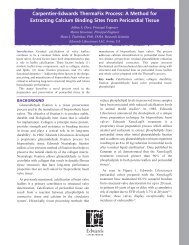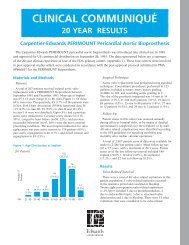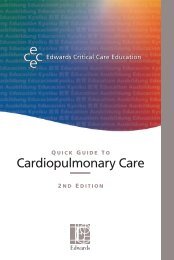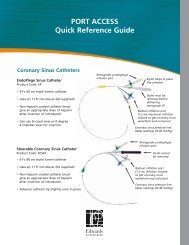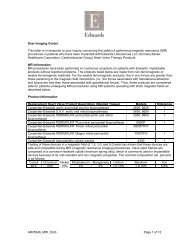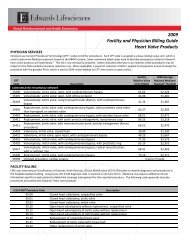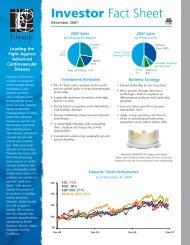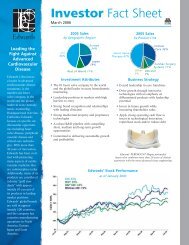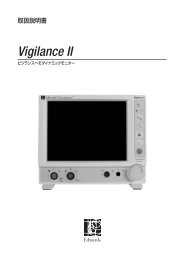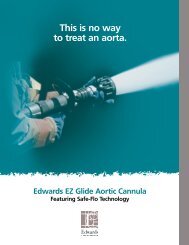Edwards FloTrac Sensor & Edwards Vigileo Monitor
Edwards FloTrac Sensor & Edwards Vigileo Monitor
Edwards FloTrac Sensor & Edwards Vigileo Monitor
Create successful ePaper yourself
Turn your PDF publications into a flip-book with our unique Google optimized e-Paper software.
<strong>Edwards</strong> <strong>FloTrac</strong> <strong>Sensor</strong><br />
&<br />
<strong>Edwards</strong> <strong>Vigileo</strong> <strong>Monitor</strong><br />
Performance Assessments of the<br />
<strong>FloTrac</strong> <strong>Sensor</strong> and <strong>Vigileo</strong> <strong>Monitor</strong><br />
1
Topics<br />
• System Configuration<br />
• Performance and Validation<br />
– Dr. William T. McGee, “Validation of a Continuous<br />
Cardiac Output Measurement Using Arterial Pressure<br />
Waveforms”<br />
– Dr. Gerard R. Manecke, “Cardiac Output Determination<br />
Using the Arterial Pulse Wave: A Comparison of a<br />
Novel Algorithm Against Continuous and Intermittent<br />
Thermodilution”<br />
– Dr. Jeffrey L. Horswell, “Arterial Pressure-Based<br />
Method of Continuous Cardiac Output <strong>Monitor</strong>ing<br />
Accurately Follows Trends in Cardiac Output During<br />
and After Surgery”<br />
2
System Configuration<br />
PreSep Catheter<br />
(ScvO 2<br />
)<br />
Venous Oximetry<br />
<strong>Vigileo</strong><br />
<strong>Monitor</strong><br />
Cardiac<br />
Output<br />
<strong>FloTrac</strong> <strong>Sensor</strong><br />
(peripheral artery)<br />
The <strong>Vigileo</strong> monitor by <strong>Edwards</strong> Lifesciences supports both the <strong>FloTrac</strong> <strong>Sensor</strong> for continuous<br />
cardiac output and the PreSep central venous catheter for continuous central venous oximetry<br />
(ScvO2)<br />
3
<strong>Vigileo</strong> <strong>Monitor</strong><br />
• Continuously computes stroke volume from the<br />
patients arterial pressure signal<br />
• Displays key hemodynamic parameters on a<br />
continuous basis (every 20 sec)<br />
• Essentially NO calibration necessary<br />
– The user simply enters patient age, gender, height<br />
and weight to initiate monitoring<br />
– Advanced waveform analysis compensates for:<br />
– Patient-to-patient differences in vasculature<br />
– Real time changes in vascular tone<br />
– Differing arterial sites<br />
• Venous oximetry available when used with<br />
appropriate <strong>Edwards</strong> oximetry technology<br />
The <strong>Vigileo</strong> monitor continuously displays and updates Continuous Cardiac Output, Cardiac<br />
Index, Stroke Volume, Stroke Volume Index, Systemic Vascular Resistance*, Systemic<br />
Vascular Resistance Index*, and Stroke Volume Variation every 20 seconds when used with<br />
the <strong>FloTrac</strong> <strong>Sensor</strong>. DO2 and DO2I are also available for intermittent calculation.** These<br />
parameters help guide the clinician in optimizing stroke volume through precision guided<br />
management of preload, afterload, and contractility.<br />
Vascular tone = vessel compliance and resistance<br />
<strong>Vigileo</strong> then helps identify the adequacy of cardiac output by monitoring central venous<br />
(ScvO2) or mixed venous (SvO2) oxygen saturation when used with <strong>Edwards</strong> venous Oximetry<br />
technologies.<br />
* These parameters require the CVP value to be slaved from bedside monitor for continuous<br />
monitoring. SVR/SVRI can also be assessed on the Derived Value Calculator for intermittent<br />
calculations using either slaved or manually entered MAP, CVP, and CO values.<br />
**These parameters require the SpO2 and PaO2 values to be manually entered. If CO is being<br />
continuously monitored, the calculator will default to the existing CO value. Otherwise, the<br />
user may override the continuous value to manually enter CO.<br />
4
<strong>FloTrac</strong> <strong>Sensor</strong><br />
The specially designed <strong>FloTrac</strong> sensor<br />
provides the high fidelity arterial pressure<br />
signal required by the <strong>Vigileo</strong> monitor to<br />
calculate the stroke volume.<br />
The <strong>Vigileo</strong> monitor uses the patient’s arterial pressure waveform to continuously measure<br />
cardiac output. With inputs of height, weight, age and gender, patient-specific vascular<br />
compliance is determined.<br />
The <strong>FloTrac</strong> sensor measures the variations of the arterial pressure which is proportional to<br />
stroke volume. Vascular compliance and changes in vascular resistance are internally<br />
compensated for.<br />
Cardiac output is displayed on a continuous basis by multiplying the pulse rate and calculated<br />
stroke volume as determined from the pressure waveform.<br />
The <strong>FloTrac</strong> sensor is easily setup and calibrated at the bedside using the<br />
familiar skills used in pressure monitoring.<br />
5
Performance<br />
6
“Validation of a Continuous Cardiac<br />
Output Measurement Using Arterial<br />
Pressure Waveform”<br />
William T. McGee, MD, MHA, et al.<br />
7
Validation of a Continuous Cardiac Output<br />
Measurement Using Arterial Pressure Waveforms<br />
William T. McGee, MD, MHA, et al.<br />
Methods<br />
•• APCO, ICO, CCO data collected from 84 84<br />
patients<br />
– (69 (69 OR OR and and in in ICU, 15 15 ICU ICU only)<br />
– 2 US, US, 2 European centers<br />
– Average age age 67.7 67.7 (+/- (+/-12.0) years,<br />
65.5% male<br />
•• Grouped measurements (562 data points)<br />
for for APCO, ICO ICO and and CCO were analyzed for for<br />
bias, precision and and correlation via via Bland-<br />
Altman analysis<br />
“Validation of a continuous cardiac output measurement using arterial pressure<br />
waveform”, Critical Care, Mar 05 supplement (abstract)<br />
Dr McGee’s study is the largest validation study of its kind. The study was conducted<br />
in 4 centers, 2 American and 2 European, in both ORs and ICUs, over a wide range of<br />
ages. This study presents a “real life” validation as patient sample bias often caused<br />
by homogeneous demographics and the effect of a limited number of participating<br />
clinical sites has been minimized.<br />
8
Validation of a Continuous Cardiac Output<br />
Measurement Using Arterial Pressure Waveforms<br />
William T. McGee, MD, MHA, et al.<br />
A wide variety of patient demographics were included in this study with broad age and BSA<br />
ranges.<br />
9
Validation of a Continuous Cardiac Output<br />
Measurement Using Arterial Pressure Waveforms<br />
William T. McGee, MD, MHA, et al.<br />
All patients recruited had an existing PAC as required for their particular therapies. Many were<br />
cardiac patients or had a history of cardiac disease. Important to note is the high prevalence<br />
of arrhythmias in the patient sample, as many pulse contour or pulse power based devices<br />
tend to have technical difficulties calculating CO through disrhythmias.<br />
10
Validation of a Continuous Cardiac Output<br />
Measurement Using Arterial Pressure Waveforms<br />
William T. McGee, MD, MHA, et al.<br />
(L/min)<br />
APCO v ICO<br />
CCO v ICO<br />
Bias<br />
Precision (+/-)<br />
Limits of Agreement (+)<br />
Limits of Agreement (-)<br />
0.19<br />
1.28<br />
2.75<br />
-2.36<br />
0.66<br />
1.05<br />
2.76<br />
-1.43<br />
Bland-Altman analysis indicates comparable variance amongst CO methods.<br />
APCO vs ICO had a lower bias as compared to the CCO vs ICO analysis. Precision (1SD)<br />
showed only a difference of
Validation of a Continuous Cardiac Output<br />
Measurement Using Arterial Pressure Waveforms<br />
William T. McGee, MD, MHA, et al.<br />
<strong>FloTrac</strong>, associated with APCO, is:<br />
* Less invasive, requiring only an existing arterial catheter<br />
* Correlates well with ICO and CCO<br />
* Performs well in a real world setting<br />
* Could be used to help monitor a population of patients who currently are not monitored with<br />
a PAC but could benefit from its most basic parameters (i.e., CO, CI, SV, SVI, SVV)<br />
12
“Cardiac Output Determination using<br />
the Arterial Pulse Wave:<br />
A Comparison of a Novel Algorithm<br />
Against Continuous and<br />
Intermittent Thermodilution”<br />
Gerard Manecke, MD, et al.<br />
13
Cardiac Output Determination using the Arterial Pulse Wave: A<br />
Comparison of a Novel Algorithm Against Continuous and<br />
Intermittent Thermodilution<br />
Gerard R. Manecke Jr., M.D., Mathew Peterson, M.D., William R. Auger, M.D.<br />
UCSD Medical Center, San Diego, CA<br />
Introduction<br />
Assessment of cardiac output using the arterial pulse wave has been accomplished with varying success, usually requiring calibration<br />
with another method(1). We tested a new algorithm based on arterial pulsatility that does not require such calibration. Comparisons<br />
were made against standard thermodilution techniques using a pulmonary artery catheter.<br />
Methods<br />
In 11 cardiothoracic surgery patients (7 men and 4 women) cardiac output (CO) was monitored immediately after surgery. An arterial<br />
pressure based algorithm calculated cardiac output from arterial pressure (APCO) in real time while a pulmonary artery (PA) catheter<br />
(777HF8 CCO Catheter, <strong>Edwards</strong> Lifesciences, Irvine, California) was used to measure continuous (CCO) and intermittent bolus<br />
thermodilution cardiac output (ICO). A laptop-based data acquisition system provided continuous calculation and storage of APCO, as well<br />
as storage of the PA-based CO determinations. Each bolus cardiac output was calculated as the average of four measurements taken over<br />
approximately 5 minutes. APCO values were determined by averaging the individual values (3 per minute) over a 5 minute interval<br />
surrounding the time of bolus determination. CCO values were taken immediately prior to the bolus determinations, and represent a 5<br />
minute average. Bland-Altman analysis, based on 65 comparison points, was used to determine bias and precision in the comparison of the<br />
CO techniques.<br />
Results<br />
The CCO range was 2.77-9.60 L/min, with the mean being 6.02±1.58 L/min.<br />
The mean bias between APCO and CCO was –0.38±0.83 L/min (figure 1),<br />
and the mean bias between APCO and ICO was 0.04±0.99 L/min.<br />
Conclusion<br />
This APCO algorithm provides a reliable, minimally invasive method for<br />
measuring CO that requires neither dilution nor CO reference for calibration.<br />
It shows strong correlation and minimal bias with both traditional intermittent<br />
bolus thermodilution and continuous cardiac output over a wide range of<br />
values.<br />
References<br />
1. J Cardiothoracic Vasc Anesth 18:185-189, 2004<br />
Supported by <strong>Edwards</strong> Lifesciences, LLC<br />
Bland-Altman plot. Mean = -0.38, 2SD = 1.28, -<br />
2SD = -2.04<br />
Critical Care Medicine. 32(12) Supplement:A43, December 2004.<br />
Dr Manecke’s study was the first <strong>FloTrac</strong> validation. Again, the comparison is with<br />
thermodilution PAC but with a smaller more homogeneous patient population. The structure<br />
of this study is more comparable to validation studies conducted for other devices as it is a<br />
small, homogeneous sample in a single center.<br />
In this study, the range of CCO data collected was between 2.77 L/min and 9.60 L/min.<br />
Variance between APCO and CCO was analyzed, resulting with Limits of Agreement of 1.28<br />
and -2.04. Precision between APCO:CCO and APCO:ICO are shown in the Results section,<br />
indicating little difference in variance between the two data sets. Thus, “It (the study) shows<br />
strong correlation and minimal bias with both traditional intermittent bolus thermodilution and<br />
continuous cardiac output over a wide range of values (when compared with APCO).”<br />
14
“Arterial Pressure-Based Method of<br />
Continuous Cardiac Output <strong>Monitor</strong>ing<br />
Accurately Follows Trends in Cardiac<br />
Output During and After Surgery”<br />
Jeffrey L. Horswell, MD, et al.<br />
15
Validation of a Continuous Cardiac Output<br />
Measurement Using Arterial Pressure Waveforms<br />
Jeffrey L. Horswell, MD and Christina M. Worley, RN<br />
Methods<br />
•• APCO, ICO, CCO data collected from 23 23<br />
cardiovascular surgery patients<br />
– Average age age 63 63 (+/- (+/-12.0) years, 65%<br />
male<br />
– All All ASA class III III or or IV IV<br />
•• Grouped simultaneous measurements<br />
(164 data points) of of APCO, ICO ICO and and CCO<br />
were analyzed and and compared for for<br />
magnitude and and direction of of trends<br />
Critical Care Medicine. Society of Critical Care Medicine 35th Critical Care Congress San<br />
Francisco, California, USA January 7-11, 2006. 33(12)<br />
Abstract Supplement:A60, December 2005.<br />
This study was presented at the 2006 SCCM to show comparisons between <strong>FloTrac</strong> and the<br />
clinical gold standard Swan-Ganz catheter’s CCO and ICO. The focus of this study was to<br />
compare the direction and magnitude change in trends between data sets: APCO vs ICO and<br />
CCO vs ICO. The patients had high ASA classifications and required monitoring with a PAC.<br />
16
Validation of a Continuous Cardiac Output<br />
Measurement Using Arterial Pressure Waveforms<br />
Jeffrey L. Horswell, MD and Christina M. Worley, RN<br />
The procedures conducted on this sample primarily were CABG, valve therapy, or a<br />
combination of the two. Patient demographics were broad, with patient ages ranging from 44<br />
to 84 and a broad range of BSAs, from 55 kgs to 151 kgs.<br />
17
Validation of a Continuous Cardiac Output<br />
Measurement Using Arterial Pressure Waveforms<br />
Jeffrey L. Horswell, MD and Christina M. Worley, RN<br />
∆ Magnitude & Direction<br />
30%<br />
The above show the differences between the comparison data being very little in terms of<br />
differences in magnitude and direction of trends.<br />
The green figures represent pairs of data with less than 15% difference in magnitude and<br />
direction; the yellow figures represent pairs of data with a 15% - 30% difference; and the light<br />
red figures represent pairs with more than a 30% difference.<br />
The differences between the two comparisons, APCO vs ICO and CCO vs ICO, were<br />
comparable.<br />
18
Validation of a Continuous Cardiac Output<br />
Measurement Using Arterial Pressure Waveforms<br />
Jeffrey L. Horswell, MD and Christina M. Worley, RN<br />
APCO responds quickly to changes in cardiac output.<br />
One of the most significant factors affecting differences in the magnitude and timing of<br />
changes in trends between the two continuous technologies, APCO and CCO, is the averaging<br />
time.<br />
As <strong>FloTrac</strong> has trends based on a 20 second averaging time, the response to changes in<br />
hemodynamics will be evident earlier than with CCO Swan-Ganz, which could have averaging<br />
times ranging from 3 to 6 minutes*, depending upon signal noise. The differences in<br />
averaging time results in time phasing of trends.<br />
•Stat mode<br />
19
Validation of a Continuous Cardiac Output<br />
Measurement Using Arterial Pressure Waveforms<br />
Jeffrey L. Horswell, MD and Christina M. Worley, RN<br />
APCO/CCO<br />
MAP<br />
PP<br />
In this example, the patient’s CO and HR remain relatively constant over the time, as shown in<br />
the APCO/CCO trend. Both MAP and PP increased over the same time span. The constant CO<br />
(and HR) with increasing MAP and PP indicates there has been a change in vascular tone.<br />
The APCO algorithm detects changes in vascular tone via analysis of waveform<br />
characteristics. CO systems based upon an indicator dilution method of calculating CO<br />
require regular calibration because they do not compensate continuously for changes in<br />
vascular tone.<br />
APCO does not require a manual method of recalibration.<br />
20
Validation of a Continuous Cardiac Output<br />
Measurement Using Arterial Pressure Waveforms<br />
Jeffrey L. Horswell, MD and Christina M. Worley, RN<br />
CONCLUSIONS<br />
•• APCO is is a new, less less invasive method for for continuous cardiac<br />
output monitoring.<br />
•• APCO requires only arterial catheterization and and does not not<br />
necessitate central venous access or or injection of of a dilution<br />
medium for for calibration.<br />
•• APCO compares favorably with trending both the the direction<br />
and and magnitude of of CO CO change as as compared to to the the clinical<br />
gold-standard, more invasive-PAC method.<br />
•• Patients who currently are are not not monitored with a PAC for for CO CO<br />
may benefit from a less less invasive method of of providing this this<br />
assessment.<br />
21
Summary<br />
• APCO is a new, less invasive method for continuous cardiac<br />
output monitoring<br />
• APCO requires only arterial catheterization and does not<br />
necessitate central venous access or injection of a dilution<br />
medium for calibration<br />
• APCO compares favorably with trending both the direction and<br />
magnitude of CO change as compared to the clinical goldstandard,<br />
more invasive-PAC method<br />
• Patients who currently are not monitored with a PAC for CO<br />
may benefit from a less invasive method of providing this<br />
assessment<br />
• APCO algorithm automatically accommodates for changes in<br />
vascular tone (without a manual method of calibration)<br />
22
Any quotes used in this material are taken from independent third-party publications and are not intended to imply that<br />
such third party reviewed or endorsed any of the products of <strong>Edwards</strong> Lifesciences.<br />
Rx only. See instructions for use for full prescribing information.<br />
<strong>Edwards</strong> Lifesciences devices placed on the European market meeting the essential requirements referred to in Article<br />
3 of the Medical Device Directive 93/42/EEC bear the CE marking of conformity.<br />
<strong>Edwards</strong>, the stylized E logo, <strong>FloTrac</strong> and <strong>Vigileo</strong> are trademarks of <strong>Edwards</strong> Lifesciences Corporation. <strong>Edwards</strong><br />
Lifesciences, PreSep, and Swan-Ganz are trademarks of <strong>Edwards</strong> Lifesciences Corporation and are registered in the<br />
United States Patent and Trademark Office.<br />
© 2006 <strong>Edwards</strong> Lifesciences LLC<br />
All rights reserved. AR01271<br />
23





